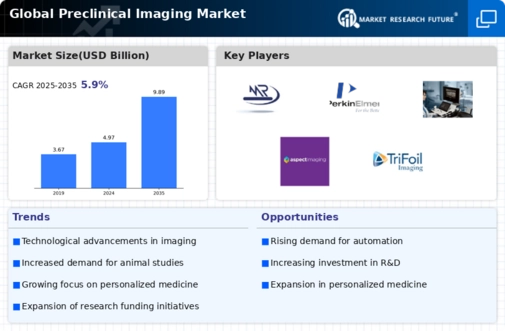Preclinical Imaging Market Summary
As per Market Research Future Analysis, the Global Preclinical Imaging Market was valued at USD 4.97 Billion in 2024 and is projected to grow to USD 9.34 Billion by 2035, with a CAGR of 5.90% from 2025 to 2035. Key advancements include Revvity, Inc.'s launch of new imaging systems aimed at enhancing preclinical research, and Mediso's introduction of the spinScan® MRI spectrometer, which offers improved imaging capabilities. The market is driven by increased R&D funding and the growing need for effective imaging techniques in drug discovery and clinical trials.
Key Market Trends & Highlights
The Preclinical Imaging Market is witnessing significant growth driven by technological advancements and increased R&D funding.
- Market Size in 2024: USD 4.97 Billion.
- Projected Market Size by 2035: USD 9.34 Billion.
- CAGR during 2024-2032: 5.90%.
- North America accounted for 45.80% of the market share in 2022.
Market Size & Forecast
| 2024 Market Size | USD 4.97 Billion |
| 2035 Market Size | USD 9.34 Billion |
| CAGR (2024-2035) | 5.90% |
Major Players
Bruker Corporation (US), MR Solutions (UK), PerkinElmer (US), Fujifilm Holdings Corporation (Japan), Milabs B.V. (The Netherlands), Mediso Ltd. (Hungary), Miltenyi Biotec GmbH (Germany), LI-COR Inc. (US), Aspect Imaging (Israel), Trifoil Imaging (US)
















